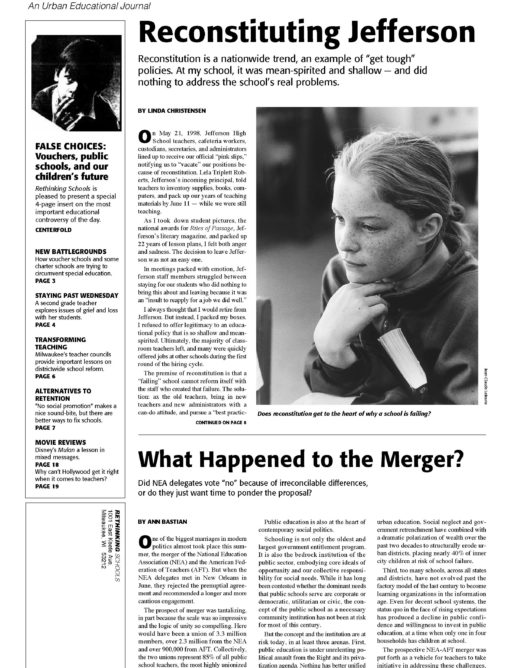Preview of Article:
Of Eagles and Chickens
How a Teacher Uses a Modern Fable to Teach about the African-American Struggle for Identity
In his journal reflection, one student, Cory, underscored the story’s contemporary applications. He wrote that the tale “was good for people in general because it is sort of how society lives and depicts in people’s minds that this is the only way to live. To society’s point of view, divide and conquer and one crab pull another crab down are the methods in which society attempts to steal and hide resources and make the rich richer, and the poor poorer.”
Kenya, meanwhile, focused on the problem of internalizing racist images and stereotypes. As part of an independent writing project for the class, she wrote the following poem.
“Sista’ Girl”
Sista girl,
Ooh yo’ hair is nappy
Why don’t you get a perm?
Look at yo’ face. You need to put some
make-up on
because you look bad.
Why yo’ nails ain’t did? You look like
you’ve
been working in the field.
Sista girl,
Why you wit’ that nigga fo’?
You better get you a white boy to
buy you shit.
Sista girl,
Where’s yo’ shoes at?
You must think you a queen or
somethin’
and can walk on rose pedals and stuff.
Sista’ girl,
What you puttin’ oils on for?
You better go to the swap meet
and get you some cheap perfume.
Sista’ girl,
Why you cryin’?
The Great Eagle Wisdom
Although Wynn’s tale is a good starting point for discussing internalized oppression, I am mostly drawn to the story because it contains the Great Eagle, a symbol of cultural resistance, hope, and liberation. This perspective is too often neglected in classrooms, especially in terms of teaching about subjugated groups.
One white student in the course picked up on this theme of resistance, and wrote how he admired the “strength and resistance shown by the Great Eagle – to be beaten and ridiculed, yet still remained resistant. All too often in this world, people persuade us through intimidation or action to give up on something or to back down. It’s good to read a story about taking the blows and still standing by your convictions.”</p

